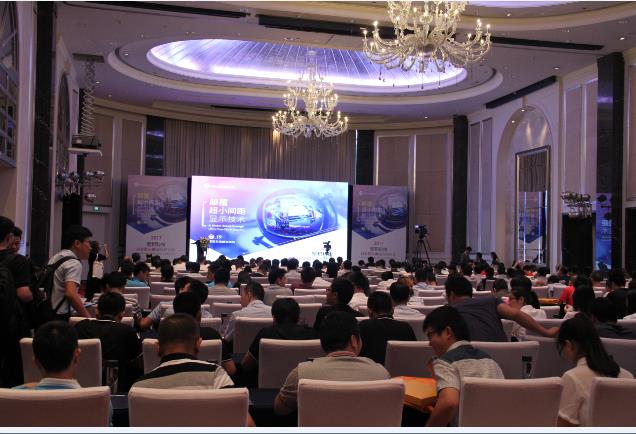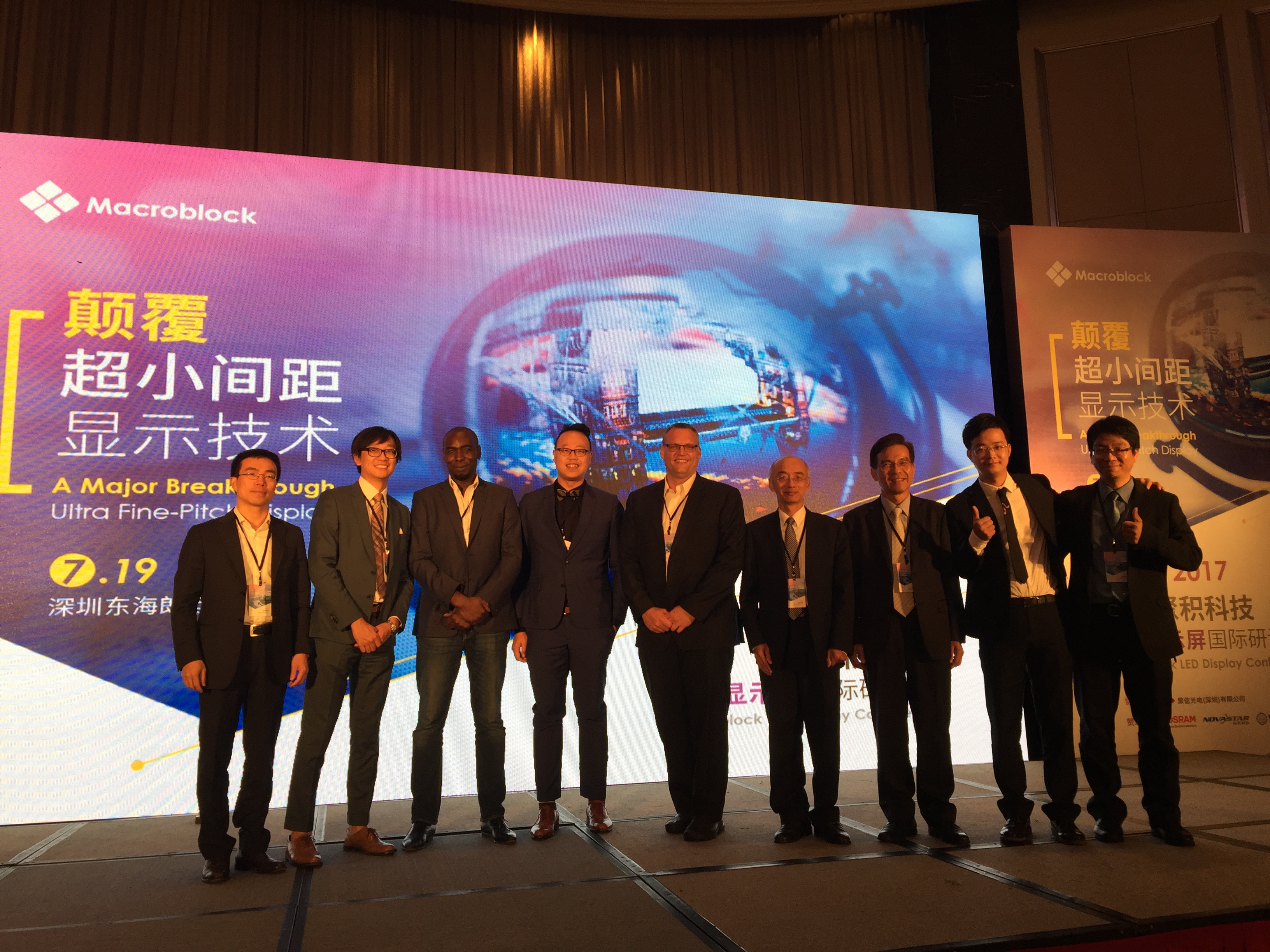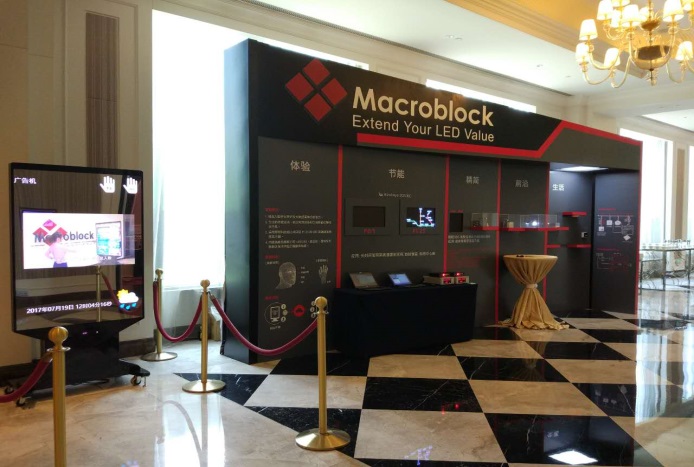CLOSE
Search for “” keywords, total search results
CLOSE
Search for “” keywords, total search results
2017.July



2017 Macroblock LED Display Conference gathered the LED display industry leaders and experts at Shenzhen Langham Hotel to share the new industry trend “ Major Breakthrough: Ultra Fine-Pitch Display” on July 19th. The theme emphasized on the industry transformation and new market requirements, applications and challenges.
In the opening speech, Macroblock’s chairman Li-Chang Yang mentioned in the past three years. From 2014 to 2016, pixel pitch around 3mm is a multitude of applications for fine pitch LED display. Pixel pitch 1.25mm led a new market trend starting from 2017, and it will move forward to less than 1mm in the next two years. The smallest pixel pitch will not be limited to viewing distance or environment (e.g. smart wristband, smart phone, VR and interaction LED display). When an LED display brings some interaction and scenario, it may overturn the impressions and feelings of customers. To interact with audiences, Macroblock exhibited an advertising LED display incorporated with internet of things technology. It has face recognition function to identify gender and age to display personalized ads. With this technology, LED displays may be associated with useful and relevant information to viewers just in time.

Following the IoT trend, Robert Chen, General Manager of Macroblock, continued with “Transformation”. For the past ten years, we can see that the outdoor LED display application was at its peak from 2008 to 2013, such as the well-known successful cases at Olympic Games 2008 in Beijing, and at EXPO 2010 in Shanghai. Until SONY launched its first LED TV, LED displays started to move to indoor applications. Therefore, Macroblock keep devoting to provide the corresponding LED driver ICs and solutions to accord with the demands of the market, such as the solution to challenges of fine pitch LED displays. In 2017, our new challenge will focus on pixel pitch within 1mm with a whole new technology: micro-LED, which is expected to be realized on smart devices, portable devices, AR and VR applications. The second challenge will be incorporating IoT with LED displays, which we expect to see a new business model in LED display industry.
Virtual Reality is no longer just a science fiction. VR combined with digital signage, however, can create a variety of unique customer experiences. BlueWater Technologies is one of the most trusted event staging and audio & video integrators by using LED video walls in the USA. Doug Wack, Vice President of Product Development of BlueWater Technologies, shared two applications at the conference. The first application is: VR Studio Concept, providing an experience focused Virtual Reality visualization center for use by FOC employees and clients. Wall to Wall LED solution allows the room to be transformed into nearly any landscape imaginable. Windowing capability within LED control system allows mirroring of VR source to provide VR PC view directly within any area on LED canvas. The second technology is: “Holodeck” Technology Exploration, providing an experience focused Virtual Reality visualization center for use by potential tenants to see their space. The position of the 360° camera relative to the center of the spherical projection drives the UVs of the containing geometry. This effect accommodates the corners of the room, providing a true 360° view of the photographed panorama. “Due to the very close viewing distance, image defect becomes apparent or amplified. Therefore, we are very strict with the images at low grayscale, such as color shift and non-uniformity at low greyscale, ghosting and bright lines, etc. Hawkeye solutions are in our good graces. ” said Doug Wack.
With the concerns of image quality, LED display walls are intended to create a strong impression, and make that first impression as lasting as possible. So the image qualities and product reliabilities are essential for fine pitch LED displays. OSRAM’s China Marketing Manager, Byron Liang, started with the four major challenges of an LED display: image quality, product reliability, power saving and price. The image problems of an LED display include appearance deformation, discoloration, color shift, LED dead pixel, and etc. He commented the most common testing methods for users to improve the LEDs reliability, OSRAM also launched 1010 package in 2014, and the smaller package 0808 for indoor fine pitch LED display went to market in 2016. This year, 2828 package is launched for high brightness contrast outdoor applications. At last, OSRAM showed a global success story: the largest 4K LED display in the world, cooperated with Macroblock, located at Marriott Hotel at Times Square in New York.
In addition to monitoring the LED quality for better visual effects, controllers can also provide different solutions. Brompton Technology Ltd. is a UK controller company providing total engineering solution for rental market. Elijah Ebo, Programme Manager of Brompton Technology Ltd., introduced three special functions of their controllers to further enhance the image quality: OSCA (On Screen Color Adjustment), Chroma Tune and Dark Magic. OSCA is designed to help technician quickly solve common visual problems, and to achieve a smooth image on LED displays; Chroma Tune can make precise adjustments to the colors in the incoming video signal and ensure corporate logos are rendered in the correct colors; Dark Magic is designed for indoor and on-camera applications. It can improve the appearance of panels operating at less than their maximum brightness, reducing banding and increasing detail in dark areas; this technique allows processing the grayscale dpi up to 26 bit per color processing. “All these functions are fully compatible with existing and new driver chips such as MBI5359” Elijah Ebo said.
Demand for brighter and more efficient displays, increased adoption of near-eye display (NED). The micro-LED market size is expected to grow over 50% from 2019 to 2025, and it will take the lead for next generation of fine pitch LED display. Macroblock’s micro-LED Product Manager, Kerry Huang, listed the future applications of micro-LED: flexible display, smart wristband, micro-LED display, AR/VR and smartphone. It is quite a challenge for micro-LED processing from epitaxy, luminous efficacy, and mass transfer. “However, the LED’s viewing angle will be wider, and the brightness and contrast may be enhanced due to package elimination. But the wavelength tolerance of chips must be under ±2nm in the epitaxy process to decrease the yield rate when sorting dies. The above challenges are still to be overcome. ” said Kerry Huang. “The LEDs cost will be reduced by 82% and BOM cost will be reduced by 32%, if the yield rate of mass transfer can be overcome. We expect to see micro-LED to be applied on the indoor LED fine pitch displays next year. ” Kerry Huang continued.
Since micro-LED has become a hot topic in LED display industry, Macroblock’s newly launched driver IC MBI5359 for micro-LED applications was the center of attention in the conference. Macroblock’s LED Display Product Manager, Freddy Lo, introduced the MBI5359 (Hawkeye 300), a high integration solution and first solution for micro-LED, featuring BGA package, modularized layout solution, high specifications and LED failure prediction. 1. BGA package: Free space of PCB bottom layer and reduce the BOM cost of PCB material.2. Modularized layout solution: Easy to layout and get the product to market faster.3. High specifications as below:(a) High integration: Control 512 pixels and reduce the high contrast interference issues.(b) High grayscale: The first original 16 bit grayscales technology for 8 scans. (c) High refresh rate: More steadier and less flicker.(d) LED failure prediction: Detect the LED statues before failure. In addition to those functions, MBI5359 also includes smart power saving function that may save power up to 25%.
“The ultimate goal of the LED display technology is providing virtual reality experiences to audiences.” said Aaron He, Vice President of Novastar. The image performance and user-friendly software are critical for LED displays. In particular, the grayscale resolution is still the challenge ahead for fine pitch LED displays. There are two reasons why LED displays may lose grayscales; one is grayscales of the video source, and the other is insufficient grayscales of LED displays. Nova can increase the grayscale resolution to 18 bit by the controller with high grayscale input to make up the problems of losing grayscale.
Last but not least, Larry Lee, General Manager of Macroblock (China) Inc., summarized all the fantastic speeches and reaffirmed that market trend of LED display will focus on value-added products in the nearly future; however, combining with Internet of Things or developing the new technologies in micro-LED’s application will bring a fresh look to the industry. Macroblock hosts conference annually to invite industry experts together with only one and simple goal: share and analyze the market trends and challenges, and create a new generation industrial ecology.